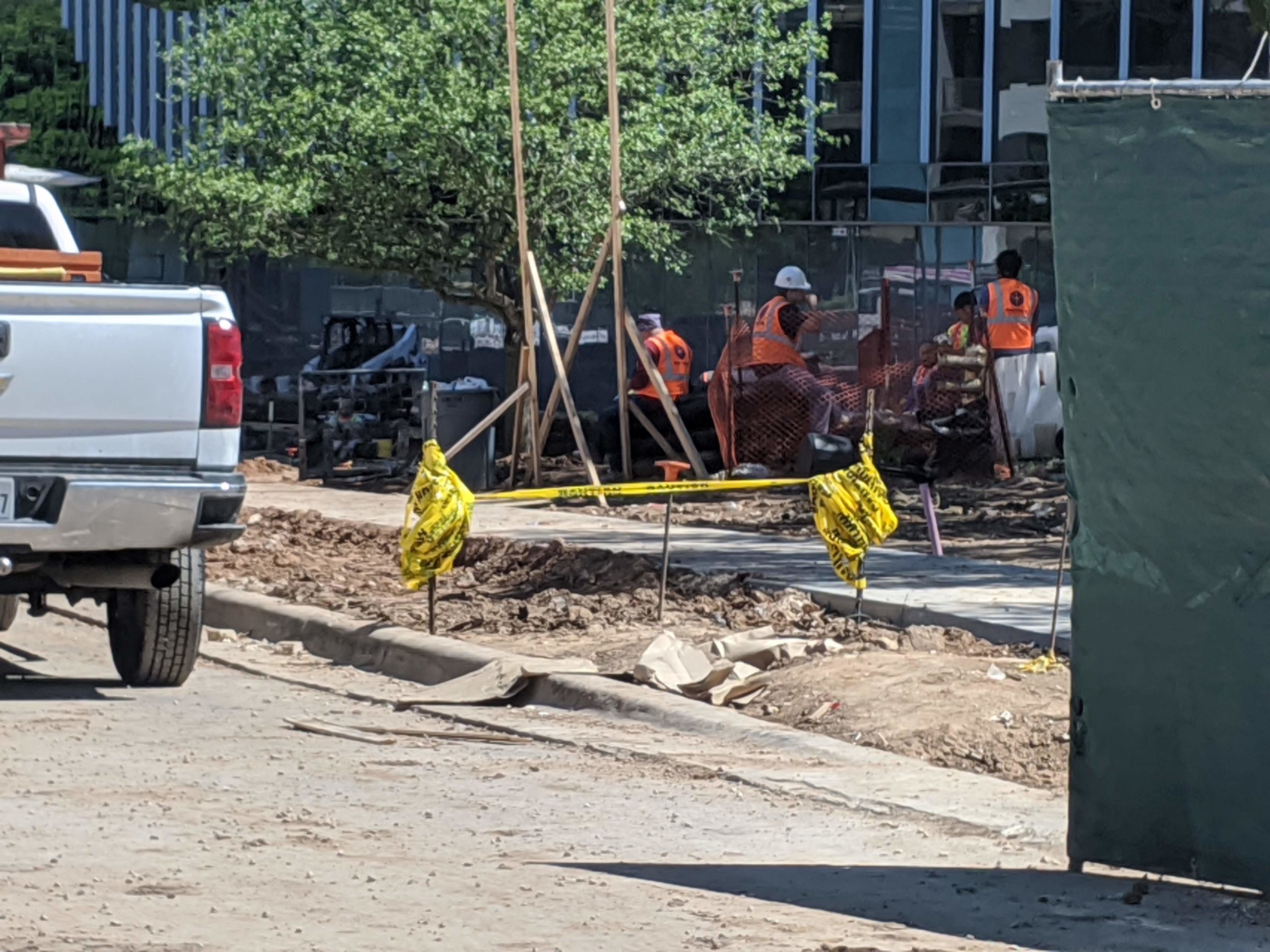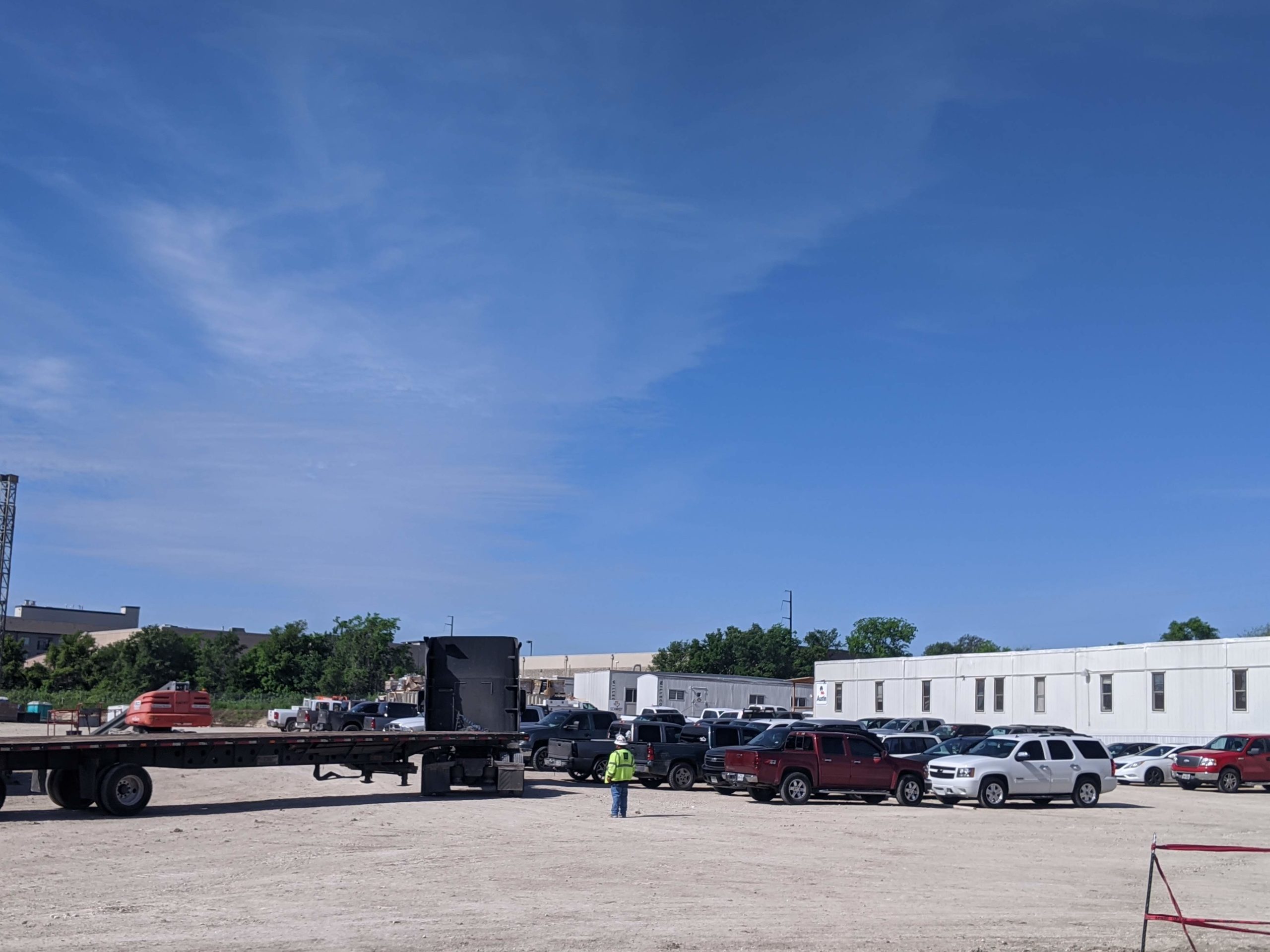On Wednesday morning, as America’s COVID-19 death count neared 5,000 and workers flooded state agencies with a record-shattering deluge of unemployment claims, business carried on as usual at the site of a future soccer stadium in North Austin.
Dozens of workers shimmied up ladders, loaded vehicles, and toted steel beams to and fro. Without facemasks, they huddled together to plan out next steps in the project. Across town, dozens more workers who were building luxury apartments and expanding the campus of the tech giant Oracle did the same. At lunch time, a woman arrived with a trunk full of meals in styrofoam containers; the workers crowded together, eager to retrieve the food.
Such scenes are playing out all over Texas and the nation. As many white collar professionals work remotely, and laid-off service workers desperately seek unemployment insurance, construction laborers are still reporting to job sites. Like medical professionals and grocery workers, they’ve been deemed “essential.”

To try to keep construction workers safe, some employers are staggering shifts and providing handwashing stations. Local governments including Dallas and Travis counties have instructed site managers to keep six feet of space between individuals and take workers’ temperatures at the beginning of each day. But some workers and advocates suggest that—like I witnessed Wednesday in Austin—the guidelines won’t be fully implemented. At a typical construction site, hygiene is an afterthought at best, they say, noting that workers routinely share cramped spaces, tools, and germs.
“Social distancing in construction isn’t a thing,” says Ryan Pollock, an Austin-area electrician and member of the International Brotherhood of Electrical Workers (IBEW). Pollock was recently working at an Austin jobsite where he says handwashing stations were routinely out of water and he labored in close quarters with unmasked colleagues. Out of fear of bringing the virus home to a family member with severe asthma, he left the job. The president of Pollock’s local union, Michael King, scoffed at the notion of social distancing on construction sites. “There’s no way that it’s possible,” he says. “They can tell guys about it, but there’s no enforcement. You can’t really do it.”
Other advocates are a bit less pessimistic about distancing. “I think you can get 6 feet apart; it’s gonna be difficult, but it’s better than a bunch of people dying,” says Ronnie Smitherman, director of the Texas Building and Construction Trades Council. But Smitherman also acknowledges that there are serious challenges. “I’ve been a construction worker for 44 years; you never have enough restrooms, and you hardly ever have a place to wash your hands.”
The risks that construction workers are facing—and the risks the industry poses to public health by forging ahead on projects—have also sparked a debate about what types of construction are “essential.” Everyone can agree that hospitals and medical facilities must be built or maintained during a pandemic, but what about market-rate housing and sports stadiums? In New York, that debate took on new urgency when a construction laborer working on offices for Google died from COVID-19 late last month; Governor Andrew Cuomo has since frozen most construction statewide.
In Dallas County, officials issued not only safety rules but also a pause on “elective additions and maintenance.” In Travis County, officials tried a more ambitious approach but, as so often happens, the governor has smacked them down.

On March 24, Travis County and the City of Austin enacted stay-at-home orders with construction guidelines that builders claimed were unclear and unhelpful. Construction largely continued. On March 30, those local governments issued new guidance that generally forbade commercial construction of new buildings and residential construction except for affordable housing. Builders’ associations wailed, and, again, much construction continued; in an industry driven by tight deadlines, there was a lot of money to lose.
On Tuesday, Governor Greg Abbott intervened with a statewide order—which resembles but most certainly is not a “stay-at-home” order—that deemed a number of sectors “essential,” including construction. Since then, Travis County and Austin have dropped their construction restrictions.
Scott Norman, director of the Texas Association of Builders—whose employees are currently working remotely—lauded the governor’s action, saying it was important for all housing construction to continue. “Not having an adequate housing stock for Texans that need a place to live … would make what is already a bad situation for our state and nation only worse,” Norman says.
But King, the IBEW president in Austin, remains frustrated. “People who work with their hands, the most economically vulnerable, they’re putting themselves in harm’s way needlessly because a contractor’s looking to make money until the end,” he says.
Of all construction laborers, the workers in the toughest bind are undocumented immigrants—who compose as much as half of Texas’ construction workforce. If their work site shuts down or they’re otherwise unable to work because of COVID-19, undocumented immigrants have no chance to draw unemployment insurance. And they were also excluded from the stimulus checks approved last month by Congress. They either work and expose themselves to the virus, or face a total collapse of income.
Fidel, a 55-year-old plumber who asked to have his last name withheld, has lived and worked in Austin for 22 years. He’s also an undocumented immigrant from Mexico. At his current job site, workers are still sharing tools, most aren’t wearing masks or even gloves, and the handwashing stations are often out of water. If he didn’t have to worry about money, Fidel says he would stay home to protect his health. But with a wife and daughter in Mexico who depend on him financially, that’s not an option—a situation he says he shares with his fellow undocumented workers. “The reason we can’t quit is because people depend on us,” Fidel says. “We don’t have access to the government benefits, so we’re under pressure to work.”
Emily Timm, co-director of the Workers Defense Project, says the government should support undocumented workers so that all unnecessary construction can be temporarily halted without wrecking families. She also notes a bitter irony. “It’s absurd: You say these workers are ‘essential’ to our economy, but they’re not essential enough to take care of if they become sick or are unable to work.”
Timm’s organization is now crowdsourcing a small emergency fund for undocumented workers and their familes.
Find all of our coronavirus coverage here.
Read more from the Observer:
-
Migrants and Advocates Call to Close Detention Centers as COVID-19 Spreads: A new lawsuit argues that an outbreak in detention could overwhelm local health care systems.
-
As Texans are Exposed to Dangerous Pesticides, Lawmakers Aren’t Doing Anything: Pesticide drift is exposing rural Texans to dangerous chemicals. But lawmakers are more concerned with how that is eating into Big Ag’s balance sheet.
-
The Future of Fair Housing in Texas: John Henneberger has spent 45 years advocating for Texans’ right to have a safe, affordable place to live.







